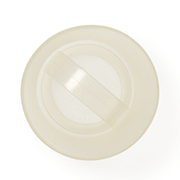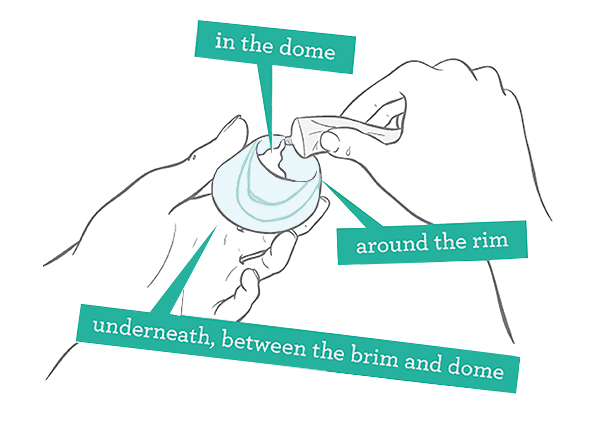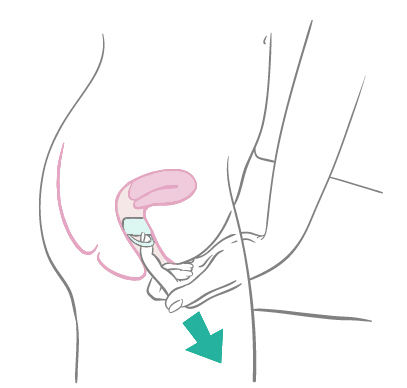- Birth control
- Cervical cap
Cervical cap

What is a cervical cap?
The cervical cap is a reusable silicone cup you fill with spermicide and insert deep into your vagina before penis-in-vagina sex. The cervical cap covers your cervix and keeps sperm from entering your uterus and fertilizing an egg. The spermicide you use with it makes sperm less able to move. FemCap is the only brand of cervical cap available in the U.S. today.
The cervical cap looks like a little sailor’s hat, with a wide, upturned brim. There are three different sizes of FemCap, and a provider will figure out which size you need, which is based on whether you’ve been pregnant before and how that pregnancy (or pregnancies) ended. You don’t have to see a provider in person to get the FemCap, but you do need a prescription for it.
One super important thing to remember is that for the cervical cap to work correctly to prevent pregnancy, you need to use it with spermicide.
The cervical cap is similar in a lot of ways to the diaphragm, another barrier method that you use with spermicide. But the two are different in a few ways. The cervical cap has a removal strap that makes it easier to take it out, whereas the diaphragm has a small removal dome to help you take it out. You can also leave the cervical cap in for 48 hours, while you can only leave the diaphragm in for 24 hours. Finally, the diaphragm is more effective at preventing pregnancy than the cervical cap if you’ve ever had a full-term vaginal birth.
Quick Facts
-
Effectiveness
The cervical cap is pretty effective the way most people use it. It’s more effective when used with spermicide.
Perfect use: Not enough data
Typical use: 71% to 86% effective
What are perfect use and typical use?
-
Hormones
The cervical cap is hormone-free.
-
Side effects
Irritation or discomfort are possible.
-
Cost
Pay once for fitting ($0-$200) and the cap ($0-$89); ongoing cost for spermicide of around $1 per dose.
-
STI protection
The cervical cap doesn’t protect against STIs.
-
Ongoing effort
You have to put it in place every time you’re going to have sex.
The cervical cap might be for you if...
Effectiveness at preventing pregnancy is NOT your top priority.
The cervical cap is not considered one of the most effective methods of birth control out there.
The effectiveness of the cervical cap depends on whether you’ve been pregnant and/or had a vaginal birth before:
- If you’ve never had a full-term vaginal delivery, the cervical cap used with spermicide is 86% effective at preventing pregnancy. That means that with perfect use, on average, 14 out of every 100 people who’ve never had a full-term vaginal delivery and are using the cervical cap for a year will get pregnant.
- If you have had a full-term vaginal delivery, the cervical cap with spermicide is 71% effective at preventing pregnancy. That means that with perfect use, on average, 29 out of every 100 people who’ve had a full-term vaginal delivery and are using the cervical cap for a year will get pregnant.
But most people don’t use the cervical cap perfectly. Most people have trouble using their cervical cap correctly from time to time. The effectiveness of the cervical cap with typical use, which means how real people use it in real life, is more relevant for most people than its effectiveness with perfect use.
We only have an average number for typical use that includes everyone using the cervical cap, regardless of whether they’ve had a full-term vaginal birth. With typical use, the cervical cap is 77% effective at preventing pregnancy. That means that, on average, 23 out of every 100 people using the cervical cap (but not perfectly) for a year will get pregnant.
You haven’t had a vaginal birth
Cervical caps are more effective if you haven’t had a vaginal birth before. That’s because having a vaginal birth changes the size and shape of your cervix, making the cervical cap not fit as well after giving birth vaginally.
The cervical cap does come in three sizes to help it fit better for people who have been pregnant and people who have given birth vaginally. The small size is for people who have never been pregnant before. The medium size is for people who have been pregnant but have not had a full-term vaginal delivery, which includes people who’ve had an abortion, a miscarriage, or a C-section. The large size is for people who have had a full-term vaginal delivery.
Even with using the correct size, the cervical cap is still less effective in people who’ve given birth vaginally than in people who have never had a full-term vaginal birth.
You want birth control without hormones.
The cervical cap is a great option for people who don’t want to (or can’t) use hormones.
You’re willing to put in some effort before having sex, every single time.
In order for the cervical cap to work, you have to use it correctly, every time, no matter what.
You’re comfortable touching your body.
Putting in a cervical cap involves putting your fingers inside your vagina. It’s a lot like putting in a menstrual cup or menstrual disc. If you’re comfortable doing that, you should be good to go.
You aren’t looking for STI protection, or you’re okay with combining the cervical cap with another method.
Neither the cervical cap nor the spermicide you use with it offer any STI protection. In fact, over-the-counter spermicide can cause irritation, especially if you’re using it multiple times a day. This irritation affects the cells in your vagina and cervix that help to fight off infections, putting you at higher risk of getting a sexually transmitted infection (STI).
So if STI protection is something you’re looking for, you can use condoms or internal condoms along with your cervical cap. Dental dams and/or gloves also offer STI protection, depending on what kind of sex you’re having. You may also want to consider PrEP (pre-exposure prophylaxis), which is a daily pill or an injection you can get every two months to decrease your risk of getting HIV.
You want a method that won’t affect your future fertility.
The only birth control method that permanently affects your fertility is sterilization. The cervical cap does not affect your ability to get pregnant after you remove it from your vagina.
You don’t mind a method that requires a visit to your health care provider.
You need a prescription to get a cervical cap, which means you’ll have to see a health care provider, but you can use telehealth instead of having an in-person visit.
You want a method that you can stop without help from a provider.
Even though you have to see a provider to get started on the cervical cap, you don’t have to see one to stop using the cervical cap. Because it’s a birth control method that you only use when you’re going to have sex, you are totally in control of starting and stopping it.
You don’t need to hide your method.
The cervical cap isn’t one of the birth control methods that is easy to hide completely. First of all, because the cervical cap is reusable, you have to store it between uses, so someone you live with may be able to find it, depending on your circumstances.
Hiding it from a sexual partner is possible but may be difficult. You can put in your cervical cap up to 40 hours before having sex, and you can leave it in for up to 48 hours, but if you’re going to have sex again while the cap is in, check to make sure it’s in place without removing it. So you may be able to avoid your partner knowing you have the cervical cap in. But there are a few situations that would make it harder to hide the cervical cap from a sexual partner:
- If you want to have sex spontaneously, you will have to interrupt the action to put the cervical cap and spermicide in before penetration (and possibly wait 15 minutes after putting it in depending on what kind of spermicide you’re using).
- If you put the cervical cap in and then don’t have sex until an hour or more later, you will need to put more spermicide into your vagina (without taking the cervical cap out).
- If you want to have sex again while the cervical cap is still in, you will need to check that the cervical cap is still in the correct position (without taking the cervical cap out) before each time you have sex.
- Your partner may feel the cervical cap during sex, though most partners don’t.
You don’t have these risk factors.
Don’t use the cervical cap:
- During your period.
- If you’ve given birth in the last six weeks.
- If you’ve had a miscarriage or abortion in the last six weeks.
- If you’re allergic to silicone or spermicide.
- If you’re having sex multiple times a day with different partners. That’s because spermicide can affect the cells in your vagina and cervix that help to fight off infections, so using it multiple times a day puts you at higher risk of getting a sexually transmitted infection (STI).
- If you are HIV negative and your partner is HIV positive.
- If using spermicide causes irritation to your vagina or vulva.
- If you have a history of frequent urinary tract infections (UTIs).
How do you use the cervical cap?
The cervical cap can be inserted up to 40 hours before sex, so you can put it in early, and it won’t get in the way of the moment. After having sex, you need to leave it in for six hours before removing it. You can leave it in for up to 48 hours, but if you’re going to have sex again while the cap is in, check to make sure it’s in place without removing it.

How to put it in
With practice, most people are able to get the hang of putting in the cervical cap pretty quickly.

Here’s how to put the cervical cap in:
- Wash your hands with soap and water.
- Check your cervical cap for holes and weak spots. Filling it with water is a good way to check—if it leaks, you’ve got a hole.
- Put a quarter teaspoon or so (about a dime-sized amount) of spermicide in the dome of the cup (which is the part that’s going to be touching your cervix), and spread some around the rim, too.
- Flip it over to the side with the removal strap and put another half teaspoon in the indentation between the brim and the dome.
- Get comfy, like you’re going to put in a tampon. Some people like to put one leg up on the toilet seat cover, while others find that squatting gives them the best access.
- Put your index and middle fingers into your vagina and feel for your cervix, so you’ll know where to place the cap. Your cervix will feel sort of hard but squishy, like the tip of your nose.
- Separate the lips of your vulva with one hand, and use the other hand to squeeze the rim of the cap together.
- Slide the cap into your vagina with the side that doesn’t have the strap on it going in first. The side of the brim that’s longer should go in first.
- Push the cervical cap down toward your anus, then up and onto your cervix.
- Make sure your cervix is totally covered.
- After sex, leave your cervical cap in for at least six hours before taking it out.
You can leave the cervical cap in for up to 48 hours total. If you have sex again while it’s in, first do a quick check to make sure it’s still covering your cervix (without removing it). Most types of spermicide will come with an applicator that allows you to insert it high up into your vagina, close to your cervix. The six-hour clock starts again every time your partner ejaculates in your vagina or on your vulva.
Here’s how to take the cervical cap out:
Once it’s been at least 6 hours since your partner last ejaculated in your vagina or on your vulva, here’s how to get the cervical cap out:

- Wash your hands with soap and water.
- Get into a comfortable position. Put a finger inside your vagina, get a hold of the removal strap, and rotate the cap.
- Push on the dome a bit with your finger to break the suction.
- Hook your finger under the strap and pull the cap out.
- After you take it out, wash it with mild soap and warm water.
- Let it air dry. Don’t use powders or lubricants on your cervical cap. (And it’s okay if it gets discolored over time, it’ll still work!)
How much does the cervical cap cost?
With health insurance
If you have health insurance—whether it’s from work, school, your parents, the ACA marketplace, or Medicaid—chances are good that you’ll be able to get this method with no out-of-pocket cost.
Without health insurance
If you don’t have insurance or if you’re on a plan that doesn’t cover birth control, the cervical cap costs $110 on the FemCap website, including the cost of getting a prescription. You have to buy spermicide separately, which costs around $1 per dose. The cervical cap should be replaced each year.
What are the side effects and benefits of the cervical cap?
There are positive and negative things to say about each and every method. And everyone’s different—so what you experience may not be the same as what your friend experiences.
The Positive
There are some advantages to using the cervical cap, including:
- You can put the cervical cap in up to 40 hours before having sex.
- You can have sex as many times as you like while it’s in, just check its position (without removing it).
- Usually neither partner can feel it during sex, although some partners can.
- It’s safe to use while breastfeeding.
The Negative
It’s normal to think about side effects, but for many people, they’re not a problem. Some side effects may include:
- Spermicide can cause vaginal irritation.
- Some people get frequent urinary tract infections when using the cap.
- It can get pushed out of place by large penises, heavy thrusting, or certain sexual positions.
In addition to potential side effects, there may be some downsides to using the cervical cap, including:
- Learning to insert it can take some practice.
- It doesn’t offer any protection against STIs (and in fact, irritation caused by spermicide can put you at higher risk of STIs).
- You have to use it every time you have sex, no matter what.
- Inserting more spermicide can interrupt sex.
Where can you get the cervical cap?
You have to get a prescription to get the cervical cap, so you can see a provider in-person or via telehealth. You can get the cervical cap itself on the FemCap site.

We can help you find an in person provider or online birth control delivery service.
find health care